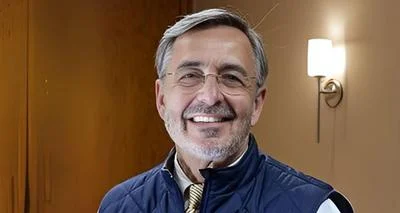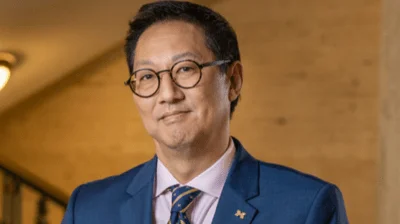University of Michigan issued the following announcement on May 22.
When Tom Pawley suffered a stroke, his wife knew exactly what was happening and exactly what to do: Call 911.
Tom Pawley has never been one to shy away from hard work. And February 6 was no exception as he worked his regular shift for Washtenaw County Parks, plowing snow after a heavy snowstorm. The night before, he was fighting an RV fire as a paid on-call firefighter in his town of Hamburg Township, Michigan.
For the man committed to helping others, it was all in a day’s work.
But returning home that night after snowplowing, everything changed for the hardworking 46-year-old.
His wife, Ruthanne, heard a bottle drop and found her husband falling to the floor. She knew immediately that Tom was having a stroke.
“He had all the symptoms,” she says.
Ruthanne understood the meaning behind FAST as it relates to stroke: Face, Arm, Speech and Time. Signs of a stroke include drooping on one side of the face, weakness or numbness in an arm and slurred speech. When these symptoms occur, time is critical. Other potential signs of a stroke include sudden onset of vertigo, imbalance and difficulty understanding what is being said.
A frightened Ruthanne didn’t hesitate to call 911, a critical step in the care of someone experiencing a stroke and something she learned from Tom, who was trained as a first responder. She never dreamed it would apply to their lives, but is grateful for being able to recognize Tom’s symptoms and for being in the right place at the right time.
SEE ALSO: Think You’re Having a Stroke? Every Minute Counts
No warning signs
Tom had no warning of the stoke that night, although a week before, during a visit to his local hospital for a stomach issue, Tom was diagnosed with atrial fibrillation, despite having no symptoms. Atrial fibrillation, or Afib, is a type of arrhythmia that affects blood flow to the heart muscle and to the rest of the body. Afib increases the risk of blood clot formation in the heart and is a common risk factor for ischemic stroke.
An appointment with a cardiologist to discuss his condition was on the agenda, but not soon enough.
SEE ALSO: Are You at Risk for Stroke? 8 Warning Signs to Know
Critical timing
Knowing time was critical, first responders, many of whom were friends and co-workers, rushed Tom to Michigan Medicine, an accredited Comprehensive Stroke Center. There, a collaborative stroke team of emergency medicine, neurology, neurosurgery and neurointerventional radiology physicians was ready and waiting.
Once he arrived, things happened very quickly, recalls Ruthanne. Tom was diagnosed with an ischemic stroke, which occurs when blood flow to the brain is blocked by a blood clot. Tom’s stroke, considered severe and potentially life-threatening, was caused by a clot that moved from his heart to his brain as a result of atrial fibrillation.
MORE FROM MICHIGAN: Sign up for our weekly newsletter
“A CT angiogram showed that the patient had a large vessel occlusion in the right middle cerebral artery,” says neurologist Sadhana Murali, M.D, who directed the administration of the intravenous blood clot-dissolving medication known as tissue plasminogen activator, or tPA. This lifesaving medication must be administered within 4.5 hours from the time a patient is last known to be completely normal before symptom onset.
But, Murali stresses, the earlier treatment can be given within the time window, the better. “Roughly 1.9 million brain cells die every minute if an ischemic stroke is left untreated, and earlier treatment is associated with better recovery outcomes, so getting to an ER for treatment as soon as possible is critical.
“Tom was brought here well within the 4.5 hour window of tPA treatment,” Murali says.
Because the location of his clot made it amenable to removal, he also underwent an endovascular thrombectomy, a minimally invasive procedure in which a device known as a stent retriever is inserted through an artery in the groin and routed up to the brain. A wire-like cage is then deployed to “trap” and remove the clot. The procedure was performed by neurointerventional radiologist Joseph Gemmete, M.D.
“In the last decade, the time windows for stroke treatment, specifically for thrombectomy, have expanded for patients who meet certain imaging criteria. This has allowed more and more patients to receive treatment,” says Murali.
Committed to stroke research
Tom was also one of the first enrollees in the MOST trial, Murali says, noting Michigan Medicine’s extensive involvement in nationwide stroke-related research. As one of the regional coordinating centers for the trial, Michigan Medicine offers certain stroke patients the option of being involved in a national clinical trial available only at select centers throughout the country.
"Roughly 1.9 million brain cells die every minute if an ischemic stroke is left untreated … so getting to an ER for treatment as soon as possible is critical. "
The goal of the MOST trial is to determine the effectiveness of combining tPA with blood thinners argatroban or eptifibatide. The research will determine whether combining tPA with either blood thinner produces better results in stroke patients in the first 90 days after suffering a stroke versus tPA with a placebo. The blood thinning medication is given intravenously, similar to tPA.
Although much of his experience was blur, Tom agreed to be a part of the study right away, says Ruthanne. “That’s the kind of person he is. If being involved in this trial can help someone, then he’ll do it.”
A remarkable recovery
Within the first few days of treatment, Tom was walking the hallways of the ICU, eager to get back home. “They couldn’t believe I was walking and called me the ‘wanderer,’” he says.
“Tom was very motivated and has worked really hard to get better,” says Murali of her patient’s recovery.
Today, Tom says he has numbness in his face and left hand and periodic slurred speech. He’s completed physical therapy and recently resumed occupational therapy to work on his fine motor skills. Rehabilitation includes walking every day and working on yard equipment to maintain the couple’s 1.5 acres of property.
“His hand-brain coordination is getting much better and his occupational therapist says he’s very much improved,” says Ruthanne.
Tom is also being treated for atrial fibrillation by Michigan Medicine cardiologist Richard Hennig, D.O. Hennig stresses the importance of paying attention to signs of a heart rhythm problem and calling 911 if you experience heart palpitations, dizziness or lightheadedness or if you pass out.
“Even during COVID-19, we encourage individuals to seek medical attention if they suspect any type of heart issue or stroke because immediate treatment is critical to saving lives,” says Hennig.
Tom agrees and is thankful for his wife’s quick thinking, his dedicated EMS co-workers and the Michigan Medicine stroke team. Without them, he isn’t sure he’d still be alive. Now on blood thinners and asymptomatic, he hopes to get back to work in July.
As a new caregiver, Ruthanne admits that life has changed for the couple. “Some days are filled with struggles. Other days are better. I’m so grateful to have been here with Tom when he had the stroke,” she says. “God put me in the right place.”
Original source can be found here.






 Alerts Sign-up
Alerts Sign-up